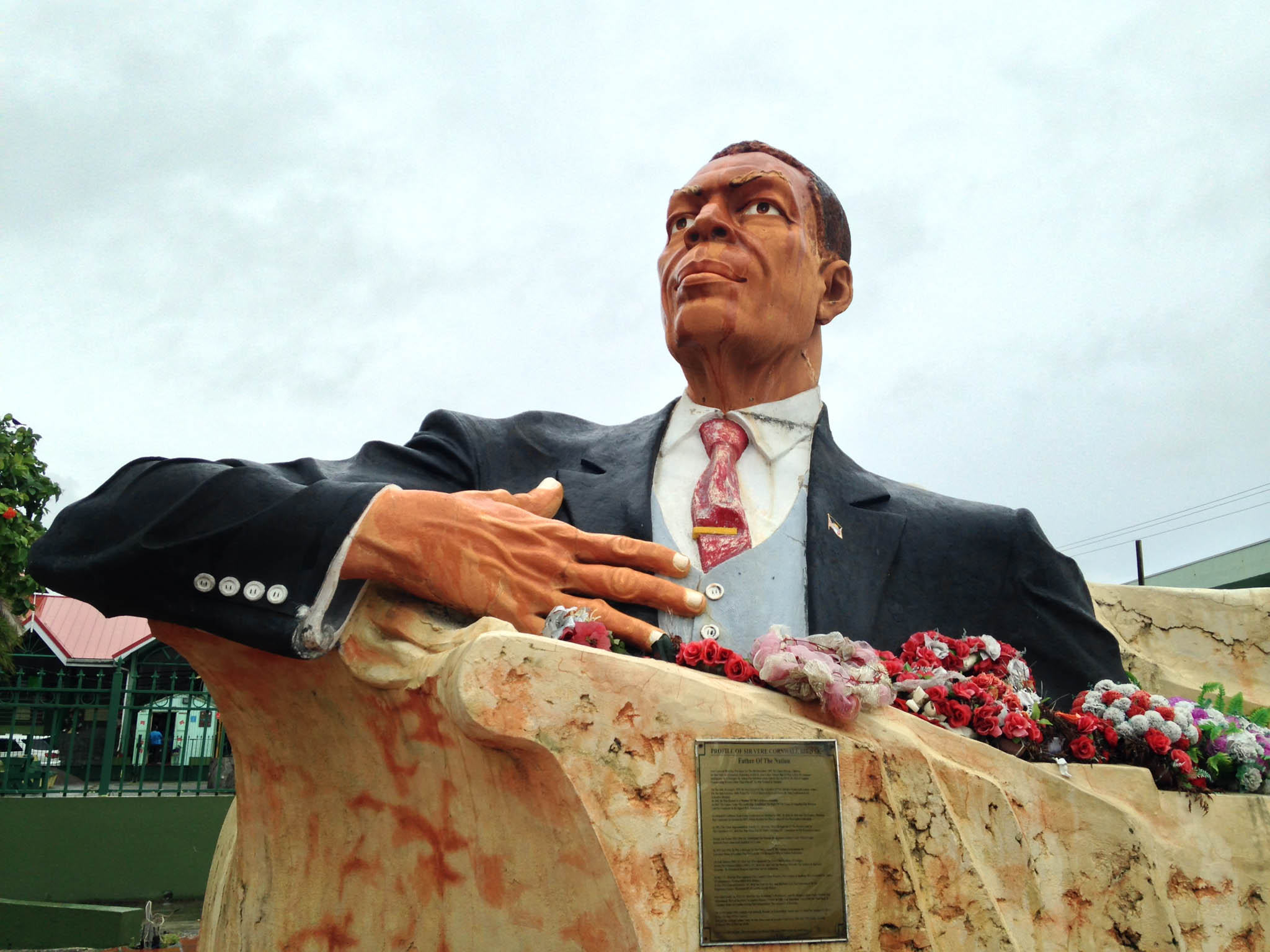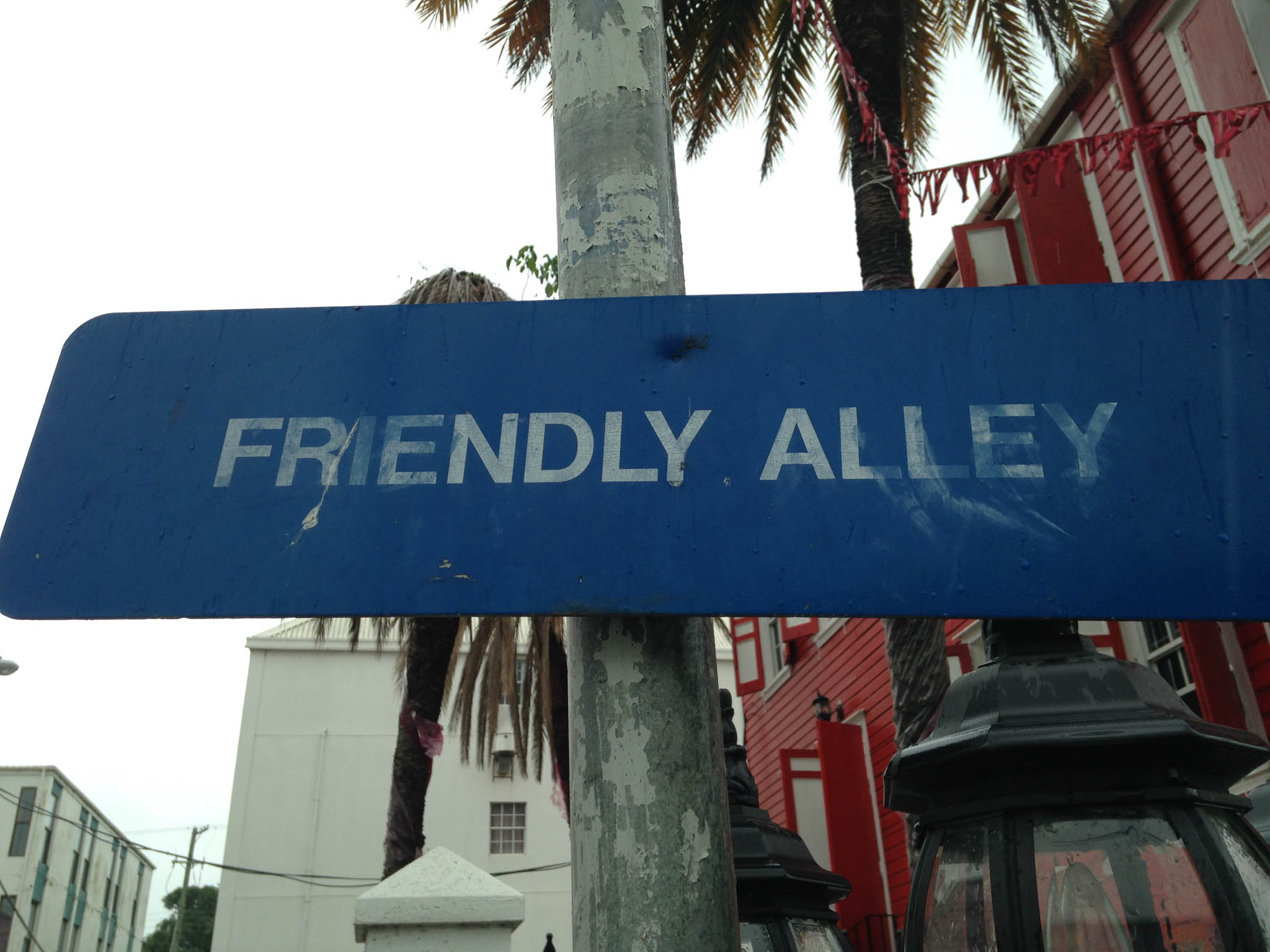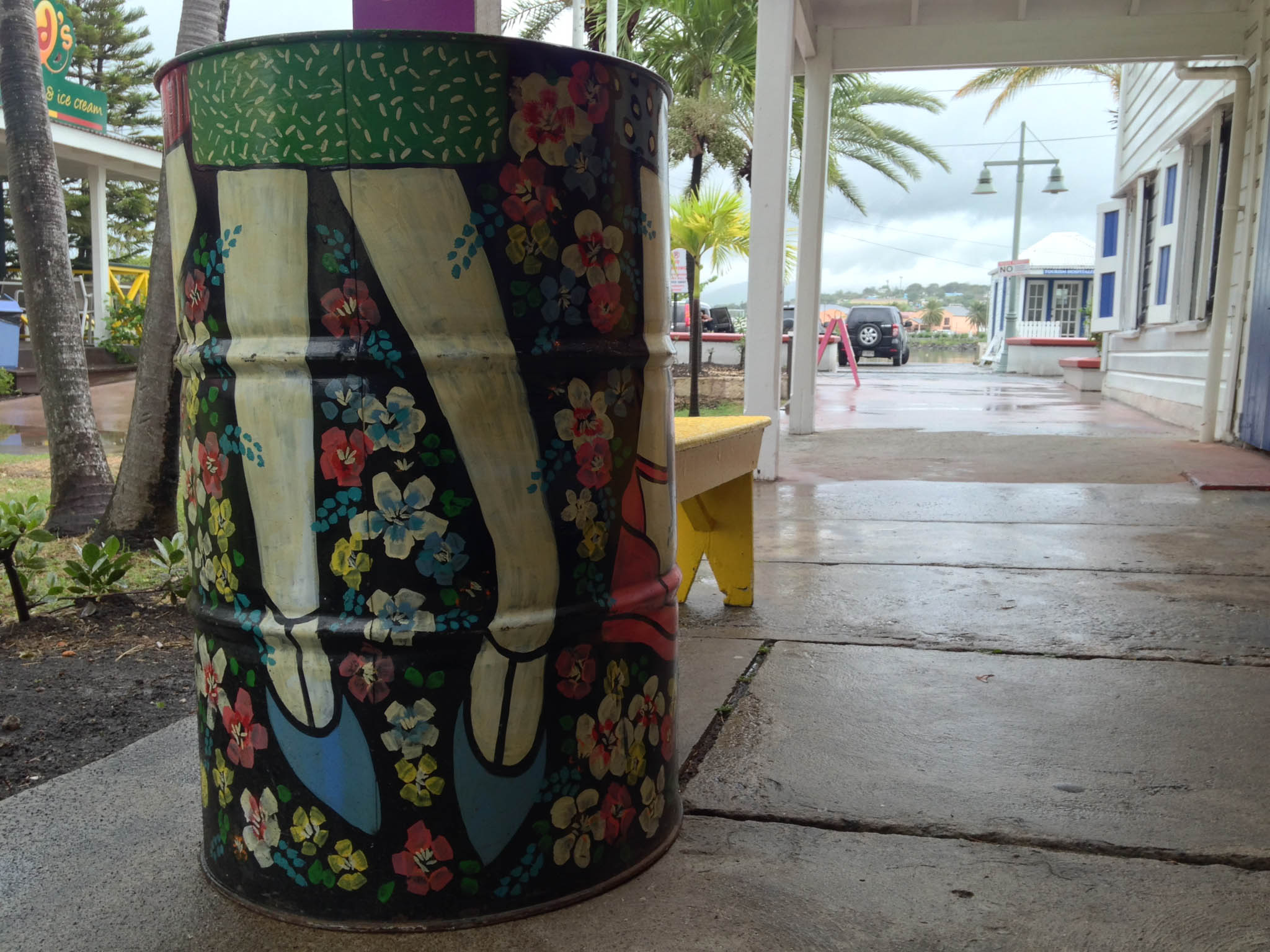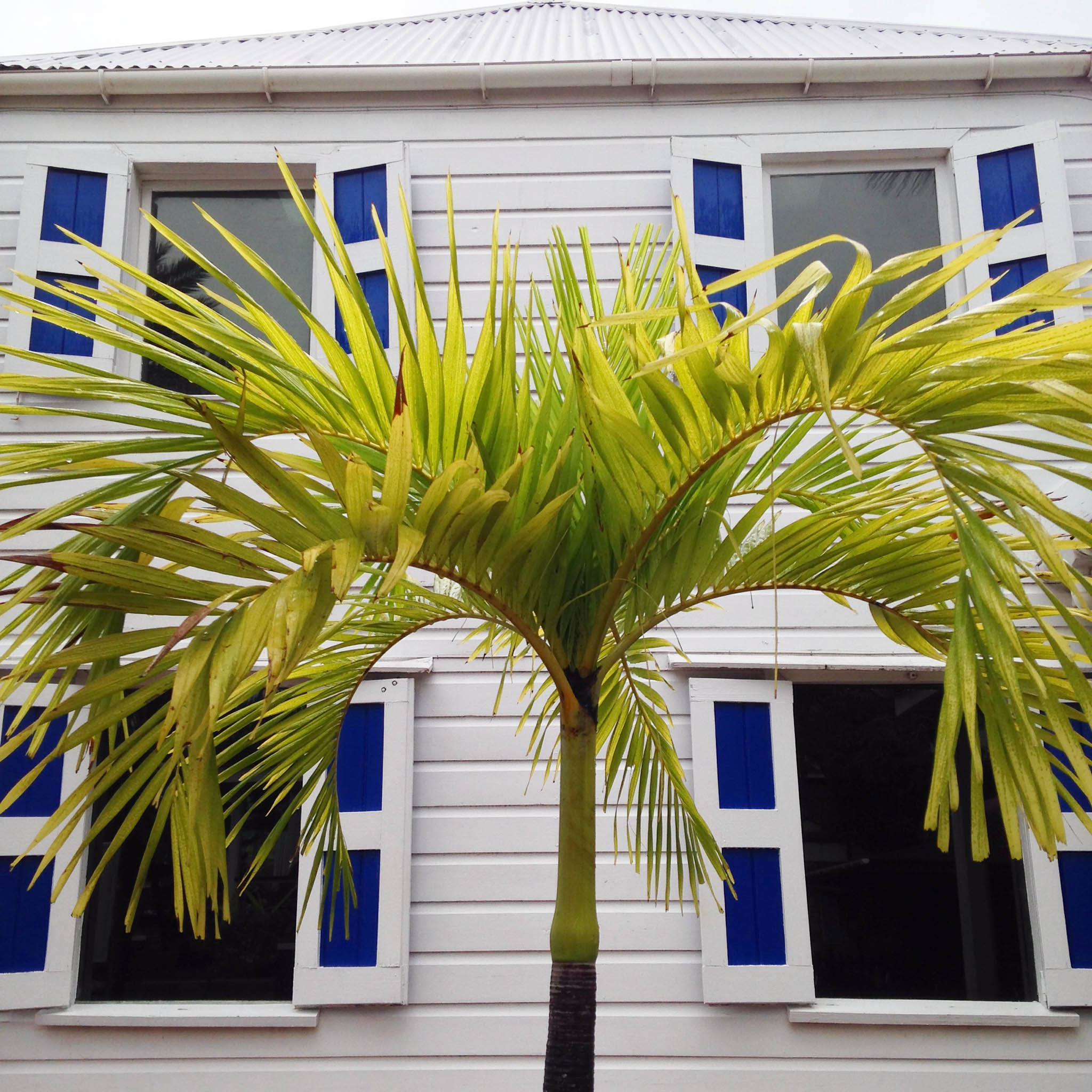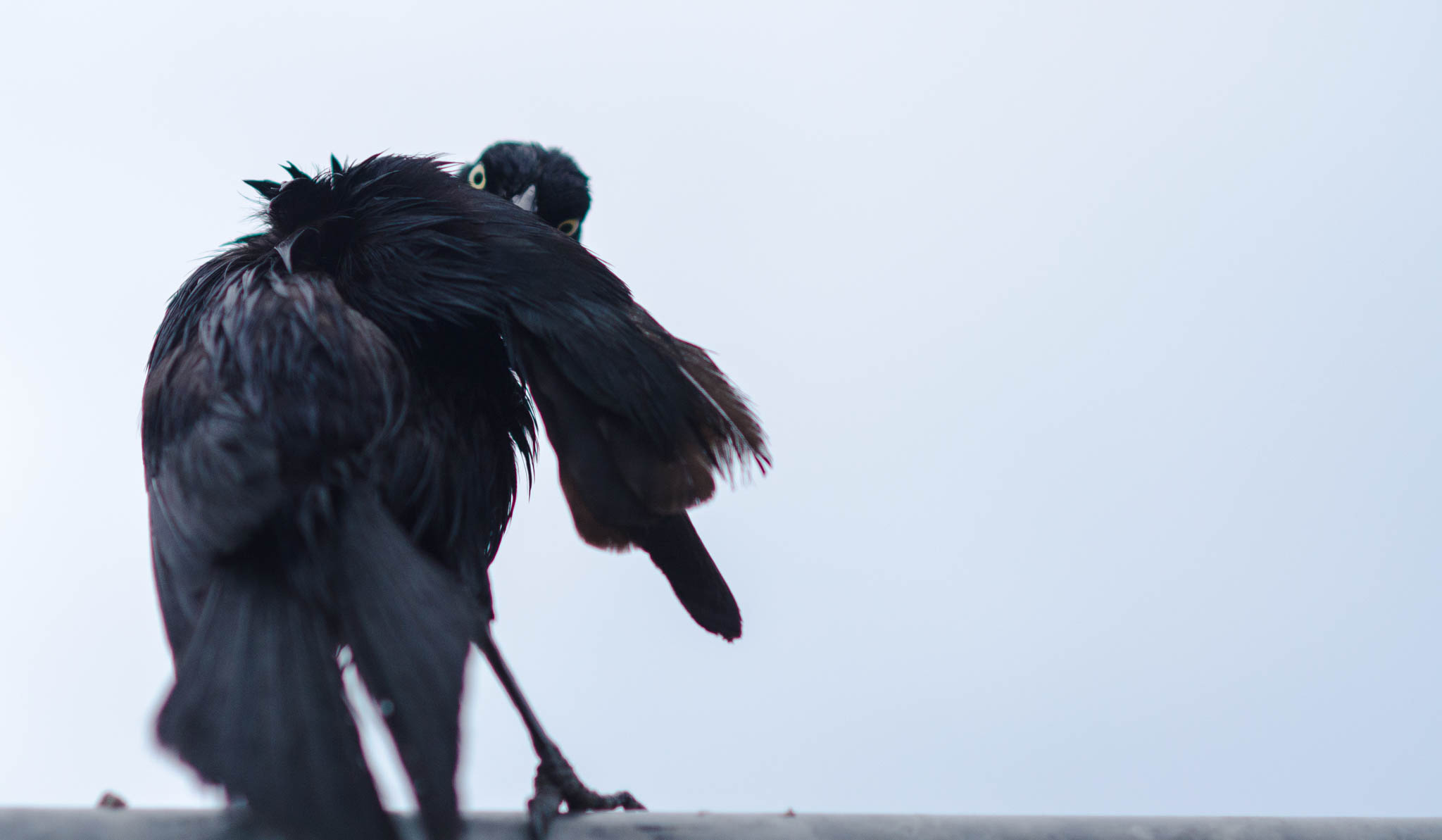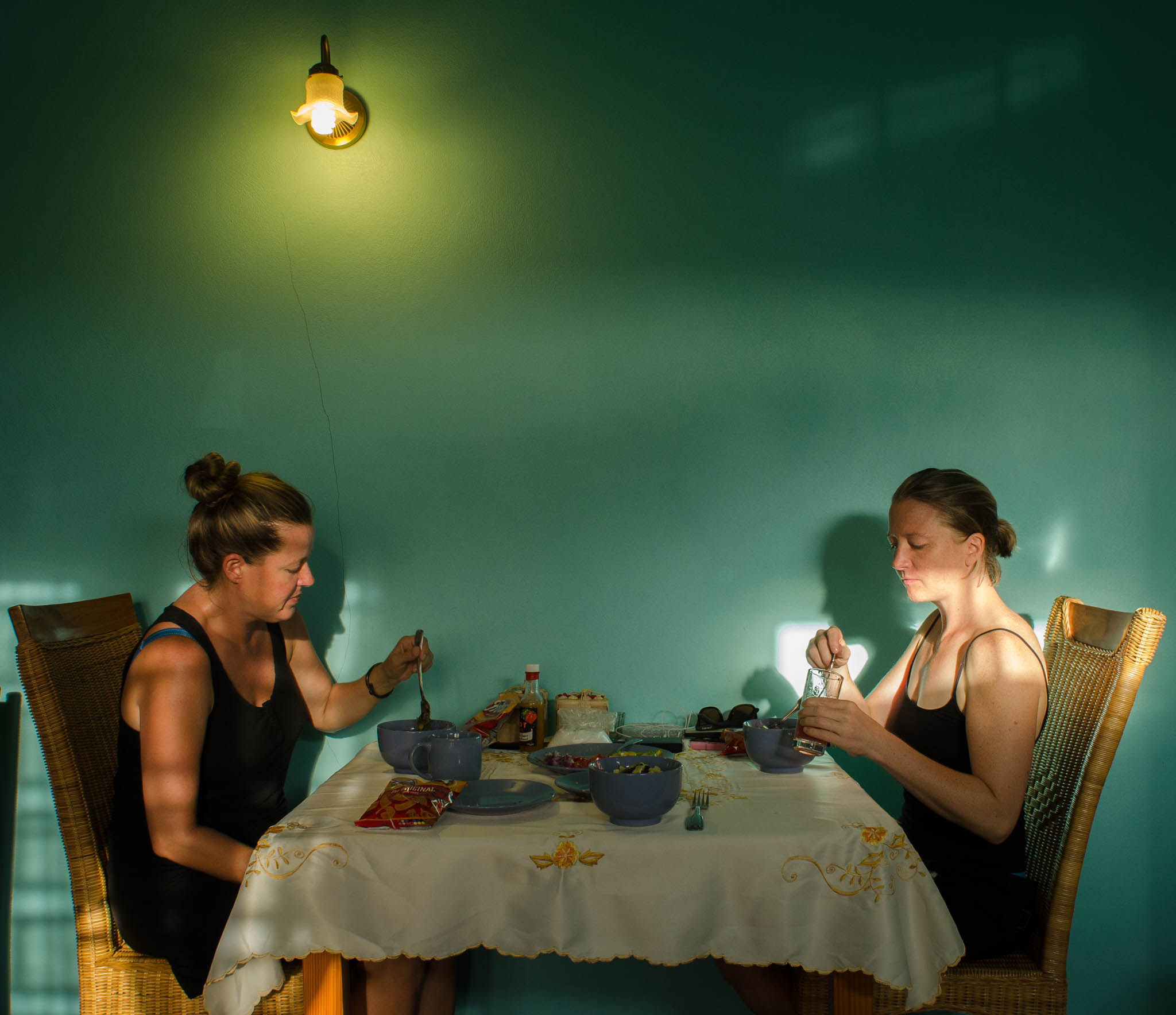Welcome Sign, Village of Willikies, Antigua
LambLion Guest Apartment, Antigua. photo -Tom Miller
By Nuin-Tara Key
Wednesday, August 20
OPOE’s visit to Antigua and Barbuda is off and running. We arrived on Wednesday evening and checked into our lovely guesthouse (the LambLion), located in the St. John’s Parish in the middle of the island.
Our driver, Jace. A big thanks to the Antigua Tourism Authority for helping with transport.
Much of Thursday was spent exploring St. John’s, the capital of Antigua and Barbuda. The city has many of the traits we have come to expect in the Caribbean – a bustling bus depot, a lively fruit and vegetable market and narrow streets packed with people and cars all moving with purpose. But, there is something unique about St. John’s – we couldn’t quite put our finger on it, but the city is welcoming in a subtle yet colorful way. Many of the buildings are brightly painted with contrasting window shutters and frames and each corner turned down another captivating street.
After exploring the craft and fruit and vegetable markets, we made our way through the rain to a late lunch. We sat under a cozy awning discussing our immediate fondness for the city while eating Shawarma.
After a quick stop for some coffee and ice cream – a luxurious treat – we made our way back to the vegetable market, where we bought soursop (something we have been looking forward to since leaving St Vincent in late July), avocados, tomatoes and passion fruit. We made our way back to our guesthouse and settled in for the evening.
Antigua and Barbuda Mitigation and Adaptation:
A Closer Look
Ms Ruleta Camacho - Video still, Tom Miller
Friday began with a stellar interview with Ruleta Camacho, Senior Environment Officer with the Ministry of Health and the Environment – a meeting we were lucky to get before her upcoming trip to Samoa. Ms. Camacho discussed the Ministry’s multi-sector focus on climate change implementation, which is currently focused on watershed health and water access, sustainable agriculture, and health. She explained, “when we think of climate change, it’s not just climate change, it’s development planning, it’s socio-economics, it’s farming, it’s health, it’s the water sector, so we try to plan holistically.” The Environment Division is the focal point for a variety of multilateral environmental agreements that seek the conservation of biodiversity, climate change adaptation and mitigation as well as sustainable land management.
It is clear from our brief meeting that Antigua and Barbuda is leading the charge in both their adaptation and mitigation efforts.
Morris Bay Beach, Antigua. Quadcopter Still - Tom Miller
It was refreshing to hear Ruleta seamlessly weave together the country’s mitigation and adaptation efforts, not falling into the entrenched bifurcation that seems to have a hold on the climate dialogue in the United States. For example, she spoke of the need to invest in alternative energy as means of reducing emissions and building resilience.
She also spoke of Antigua’s readiness to move beyond the planning phase and into implementation. To support local implementation, Antigua and Barbuda is establishing a funding mechanism (Sustainable Island Resource Framework (SIRF) Fund) that allows for a more efficient use of implementation dollars.
“...we want to avoid any more documents on a shelf or a policy about a policy, and really get to implementation.”
One of the goals of this fund is to allow for more direct and efficient distribution of funds to local communities who are ready to implement climate resilience projects. “For individuals living in Antigua and Barbuda the costs of adaptation are very, very high… we want to avoid any more documents on a shelf or a policy about a policy, and really get to implementation, because as you drive around the island you will notice that there are impacts of climate change happening and there is socio-economic livelihood impacts based on the fact that there are some parts of our society that are not able to adapt.” Ms. Camacho further explained, “there are also socio-economic impacts because your finances have to be spent on adaptation rather than economic development, rather than your own personal development, rather than on wellbeing. These issues have not been well recognized by the international community.” In response to these issues, she explained, “as you drive around the island you see Individuals in Antigua and Barbuda need to have access to financing,” and it is intended that this new funding mechanism will provide direct access to resources in a programmatic and efficient way.
Ms. Camacho also spoke of the upcoming UN Conference on Small Island Developing States (SIDS) in Samoa from September 1-4, 2014. “Although we are a developing country, although we are vulnerable small island state, we do have to make our contribution to mitigation. As Small Island Developing States, we have always been the conscience of the climate change negotiations.”
*
Following our interview with Ruleta Camacho, Edie Norde, Environment Officer, and Ann-Marie Browne, Clearinghouse Mechanism Coordinator, both with the Environment Division, joined us for an exciting tour of the Victoria Park Botanical Gardens.
Ann-Marie Browne & Edie Norde - Video Still, Tom Miller
Edie Norde and Sugar Apple plants - Video Still, Tom Miller
“So people will think small island, but certainly not small minded - because we definitely think outside of this little box... ”
The Botanical Garden
has long held an important cultural and historical place in the City of St. John’s, and is currently going through a major renovation. Soon the park will serve as a major focal point for the Ministry’s environmental and cultural learning programs. The site will also serve as a means of meeting national obligations under a number of multilateral environmental agreements (most notably the UN Conventions of Biological Diversity, Climate Change, and Desertification). Not only will the renovations provide an exceptional recreational site in the heart of the city, but the Environment Division plans to use the garden for a number of demonstration sites concentrated on the management and conservation of biodiversity, building climate resiliency as it relates to climate change adaptation and mitigation and finally, promoting sustainable land management.
“Environment Division, seeks to establish the Victoria Park Botanical Gardens as an inspirational space for showcasing effective environmental best practices, environmental learning and enjoyment. “ – Victoria Park Botanical Garden Management Plan
Both Ann-Marie and Edie spoke of the importance of shifting the climate change dialogue to an individual level and that implementation efforts need to strengthen civil society and build individual resilience. They spoke at great length of the challenges of shifting individual behaviors, but were optimistic and impassioned about the work being done through the Environment Division. Central to each of the projects they mentioned was the role of raising environmental awareness through culturally and historically relevant approaches.
Walking in the Botanical Garden - Video Still, Tom Miller
They discussed the role of intergenerational learning, youth programs and connecting people to nature through culturally significant food and agricultural practices. While discussing her work at the Environment Division, Ms. Norde concluded our tour with one of the more inspiring messages we have heard yet, “So people will think small island, but certainly not small minded - because we definitely think outside of this little box... we really want to see the development of Barbuda and Antigua move forward in a way where we respect our environment and fear it at the same time because we know at any minute it can just turn on us and so we have to be good to it.”
Impacts of Climate Change in Antigua and Barbuda
Antigua and Barbuda, like the other Caribbean countries we have visited, is highly vulnerable to the impacts of climate change. Like St. Vincent and the Grenadines and Grenada, Antigua and Barbuda is highly vulnerable to the predicted increase in frequency of intense tropical storms and hurricanes, as well as an increase in average atmospheric temperature and reduced annual rainfall.
Dry Reservoir - Video Still, Tom Miller
While these issues are consistent across the Caribbean, they create unique challenges in each location. In Antigua and Barbuda Tourism is one of the largest economic sectors, contributing roughly 80% to GDP in 2012. However, it is predicted that between ten to eighteen percent of the major tourist infrastructure are at high risk from coastal erosion and extreme storm events (since the majority of tourism infrastructure is located on, or near the coast).
Agriculture is another vulnerable sector in Antigua and Barbuda, especially related to increased drought. In the summer of 2010 Antigua and Barbuda saw severe drought conditions, which contributed to substantial crop losses. Heavy rainfall in the late summer months compounded this issue, resulting in soil erosion and landslides. 2013 and early 2014 also witnessed a drought and many of the island’s dammed reservoirs are still dry. These droughts have also lead to residential water rationing and increased dependence on rainwater catchment systems.
Wallings Dam, Now Dry - Photo, Nuin-Tara Key
Wallings Dam, Now Dry - Video Still, Tom Miller
Check out our entire archive below...
-
July 2016
- Jul 12, 2016 New Video: Puruvesi (Ice fishing in Finland) Jul 12, 2016
-
March 2016
- Mar 5, 2016 Puruvesi Mar 5, 2016
-
July 2015
- Jul 14, 2015 Almost, Exactly Average or: How I Stopped Worrying and Started to Love Crowdfunding Jul 14, 2015
- Jul 8, 2015 Summer on the Jukajoki Jul 8, 2015
-
May 2015
- May 18, 2015 What are they building in there? May 18, 2015
- May 7, 2015 No Silver Bullet: Ecomodernism, Technology, and Path Dependency May 7, 2015
-
November 2014
- Nov 11, 2014 Some Fish, Some Tango, and a Fiery Goodbye Nov 11, 2014
-
October 2014
- Oct 26, 2014 62° 39' 00" N, 30° 08' 00" E Oct 26, 2014
- Oct 14, 2014 Bluefields to Wawashang - Final Nicaragua Installment Oct 14, 2014
- Oct 3, 2014 Monkey Point & Bangkukuk: Part 2 Oct 3, 2014
- Oct 1, 2014 Monkey Point & Bangkukuk: Part 1 Oct 1, 2014
-
September 2014
- Sep 30, 2014 ¿Que Podemos Hacer Juntos? (What Can We Do Together?) Sep 30, 2014
- Sep 11, 2014 Reflections on Union and a Brief Respite with Cosmos Sep 11, 2014
- Sep 2, 2014 The Sea Will Rise, Barbuda Will Survive Sep 2, 2014
-
August 2014
- Aug 25, 2014 OPOE in Antigua or, Tarantulas, LambLions & Plumeria Aug 25, 2014
- Aug 24, 2014 A Farwell to Union, Hello Grenada Aug 24, 2014
- Aug 10, 2014 I'll Have One Film Workshop, With a Side of Chicken Fever Aug 10, 2014
- Aug 4, 2014 Island Hopping - from Bequia to Union Aug 4, 2014
-
July 2014
- Jul 30, 2014 A Sub, a Princess, Chicken and Bake - Another OPOE Week in Review Jul 30, 2014
- Jul 20, 2014 From Santa Fe to St. Vincent - OPOE's First Week in the Field Jul 20, 2014
-
May 2014
- May 30, 2014 Fast Tracking Climate Adaptation–tapping our natural tendency to experiment May 30, 2014
- May 21, 2014 Reframing Despair May 21, 2014
- May 8, 2014 May 13th Campaign Launch! Help Build Momentum May 8, 2014
- May 5, 2014 Update - letter of support from USAID! May 5, 2014
-
April 2014
- Apr 11, 2014 Project Launch! Apr 11, 2014
- Apr 10, 2014 Climate CoLab Submission Apr 10, 2014








